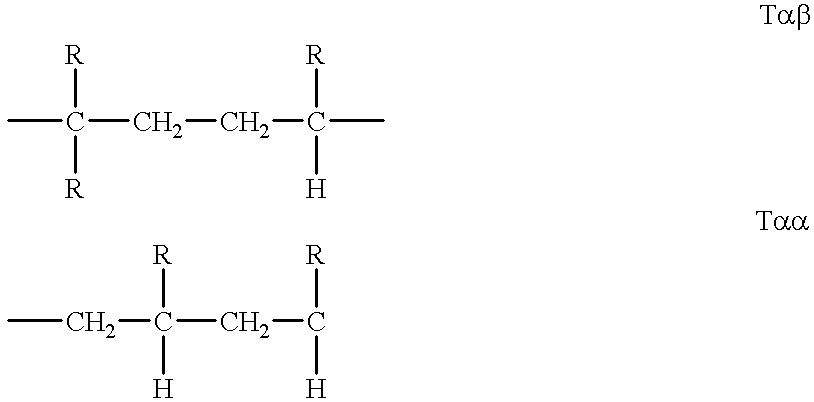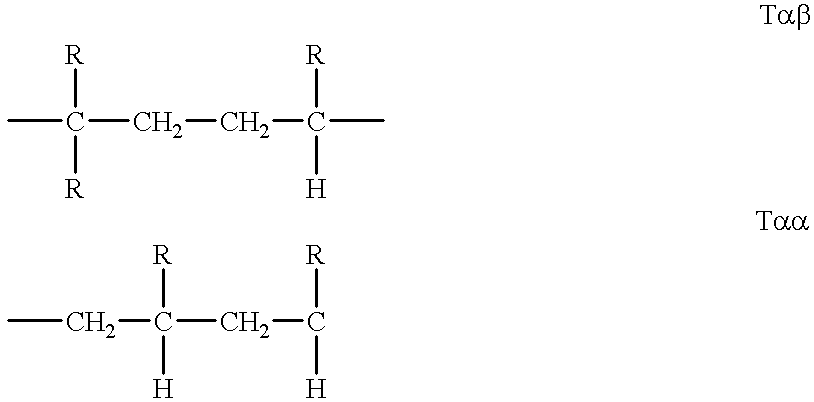Olefinic thermoplastic elastomer composition and method for producing the same
a technology of thermoplastic elastomer and composition, which is applied in the direction of transportation and packaging, special tyres, tyre parts, etc., can solve the problems of poor tensile strength and tensile elongation at break, and the characteristics are still inferior to those of vulcanized rubber, and achieve superior tensile strength. , the effect of improving the tensile strength
- Summary
- Abstract
- Description
- Claims
- Application Information
AI Technical Summary
Benefits of technology
Problems solved by technology
Method used
Image
Examples
preparation example 2
Preparation of Ethylene-1-butene-5-ethylidene-2-norbornene Copolymer Rubber (B-2)
An ethylene-1-butene-ENB copolymer rubber [copolymer rubber (B-2) ] was obtained in the same manner as Preparation Example 1 except for using rac-dimethylsilylene-bis(2-ethyl-4-isopropyl-7-methyl-1-indenyl)zirconium dichloride in place of the zirconium compound used in Preparation Example 1 (1) (i.e., rac-dimethylsilylene-bis(2-methyl-4-phenyl-1-indenyl)zirconium dichloride.). The properties of the obtained copolymer rubber (B-2) are shown in the following.
(i) Molar ratio of units derived from ethylene to units derived from 1-butene (ethylene / l-butene): 79 / 21
(ii) Iodine value based on ENB: 10
(iii) Intrinsic viscosity [.eta.] as measured in decalin at 135.degree. C.: 2.7 dl / g
(iv) Intensity ratio D of T.alpha..beta. to T.alpha..alpha. in .sup.13 C-NMR spectrum: <0.01
(v) B value: 1.1
(vi) Glass transition temperature (Tg) obtained by DSC: -56.degree. C.
(vii) g.eta.* value: 0.98
preparation example 3
Preparation of Ethylene-propylene-5-vinyl-2-norbornene Copolymer Rubber (B-3)
Using a stainless polymerization reactor having a substantial content volume of 100 liter which is equipped with a stirring blade (rotation: 250 rpm), there was conducted continuous copolymerization of ethylene, propylene and 5-vinyl-2-norbornene.
Namely, into the liquid phase from the side of the polymerization reactor there were continuously supplied dehydrated and purified hexane at 60 L / hour, ethylene at 3.6 kg / hour, propylene at 3.0 kg / hour, 5-vinyl-2-norbornene at 320 g / hour, hydrogen at 40 L / hour, as catalyst (a) VOCl.sub.3 at 32 millimol / hour, (b) diethylaluminum chloride (Al(Et).sub.2 Cl) at 160 millimol / hour and Al(Et).sub.1.5 Cl.sub.1.5 at 32 millimol / hour. The copolymerization was conducted at 40.degree. C.
The copolymerization according to the said conditions gave an ethylene-propylene-5-vinyl-2-norbornene copolymer in the state of a homogeneous solution. A small quantity of methanol was added in...
preparation example 4
Preparation of Ethylene-propylene-5-ethylidene-2-norbornene Copolymer Rubber (B-4)
Using the known vanadium catalyst (VOCl.sub.2 (OC.sub.2 H.sub.5)), copolymerization carried out of ethylene, propylene and 5-ethylidene-2-norbornene. The properties of the copolymer rubber obtained (B-4) are shown hereunder.
(i) Molar ratio of units derived from ethylene to units derived from propylene (ethylene / propylene): 79 / 21
(ii) Iodine value based on ENB: 13
(iii) Intrinsic viscosity [.eta.] as measured in decalin at 135.degree. C.: 2.7 dl / g
(iv) Intensity ratio D of T.alpha..beta. to T.alpha..alpha. in .sup.13 C-NMR spectrum: <0.01
(v) B value: 1.0
(vi) Glass transition temperature (Tg) obtained by DSC: -51.degree. C.
(vii) g.eta.* value: 0.97
PUM
| Property | Measurement | Unit |
|---|---|---|
| molar ratio | aaaaa | aaaaa |
| molar ratio | aaaaa | aaaaa |
| density | aaaaa | aaaaa |
Abstract
Description
Claims
Application Information
 Login to View More
Login to View More - R&D
- Intellectual Property
- Life Sciences
- Materials
- Tech Scout
- Unparalleled Data Quality
- Higher Quality Content
- 60% Fewer Hallucinations
Browse by: Latest US Patents, China's latest patents, Technical Efficacy Thesaurus, Application Domain, Technology Topic, Popular Technical Reports.
© 2025 PatSnap. All rights reserved.Legal|Privacy policy|Modern Slavery Act Transparency Statement|Sitemap|About US| Contact US: help@patsnap.com



